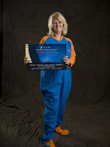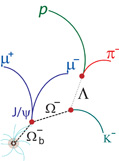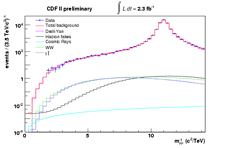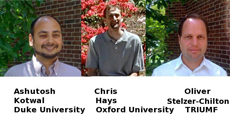|
Thursday, Sept. 4
THERE WILL BE NO PHYSICS AND DETECTOR SEMINAR THIS WEEK
1 p.m.
Research Techniques Seminar - West Wing, WH-10NW
Speaker: R. Mirzoyan, Max-Planck-Institute for Physics
Title: The Cross-Talk Problem in SiPMs and Their Use as Light Sensors in Multichannel Imaging Cameras
THERE WILL BE NO THEORETICAL PHYSICS SEMINAR THIS WEEK
3:30 p.m.
DIRECTOR'S COFFEE BREAK - 2nd Flr X-Over
THERE WILL BE NO ACCELERATOR PHYSICS AND TECHNOLOGY SEMINAR TODAY
Friday, Sept. 5
3:30 p.m.
DIRECTOR'S COFFEE BREAK - 2nd Flr X-Over
4 p.m.
Joint Experimental-Theoretical Physics Seminar - One West
Speaker: F. Vannucci, APC Paris
Title: Search for Heavy Neutrinos and Other Exotica
Click here for NALCAL,
a weekly calendar with links to additional information. |
|
Thursday, Sept. 4
- Southwestern chicken tortilla
- Philly style cheese steak
- *Garlic herb roasted pork
- Smart cuisine: Southwestern grilled chicken
- *Southwestern turkey wrap
- Assorted sliced pizza
- *Marinated grilled chicken Caesar salads
*Carb restricted alternative
Wilson Hall Cafe menu |
|
Thursday, Sept. 4
Dinner
- Pasta carbonara
- Chilean sea bass w/spicy red pepper sauce
- Sautéed spinach with garlic & lemon
- Fresh fruit tart
Wednesday, Sept. 10
Lunch
- Chile reno with a tomato sauce
- Rice & beans ~ pico de gallo
- Cold lime soufflé
Chez Leon menu
Call x4598 to make your reservation. |
|
|
Register by Sept. 5 for LHC start-up pajama party
 |
| Office of Communication Director Judy Jackson advertises Fermilab's upcoming Pajama Party |
Celebrate the start up of the Large Hadron Collider at Fermilab's Pajama Party. At 1:30 a.m. on Wednesday, Sept. 10, Fermilab will host a pajama party at the LHC Remote Operations Center to watch the first beam circulate in the LHC. Breakfast will be served following the LHC start-up. You may wear pajamas. All employees must register by 5 p.m. on Friday, Sept. 5, to attend.
|
Fermilab physicists discover "doubly strange" particle
 |
| The DZero collaboration discovered the Omega-sub-b, a particle made of three quarks. The short-lived particle travels about a milimeter before it decays into lighter particles. |
Physicists of the DZero experiment at the U.S. Department of Energy's Fermi National Accelerator Laboratory have discovered a new particle made of three quarks, the Omega-sub-b (Ωb). The particle contains two strange quarks and a bottom quark (s-s-b). It is an exotic relative of the much more common proton and weighs about six times the proton mass.
The discovery of the doubly strange particle brings scientists a step closer to understanding exactly how quarks form matter and to completing the "periodic table of baryons." Baryons (derived from the Greek word "barys," meaning "heavy") are particles that contain three quarks, the basic building blocks of matter. The proton comprises two up quarks and a down quark (u-u-d).
Combing through almost 100 trillion collision events produced by the Tevatron particle collider at Fermilab, the DZero collaboration found 18 incidents in which the particles emerging from a proton-antiproton collision revealed the distinctive signature of the Omega-sub-b. Once produced, the Omega-sub-b travels about a millimeter before it disintegrates into lighter particles. Its decay, mediated by the weak force, occurs in about a trillionth of a second.
Theorists predicted the mass of the Omega-sub-b baryon to be in the range of 5.9 to 6.1 GeV/c2. The DZero collaboration measured its mass to be 6.165 ± 0.016 GeV/c2. The particle has the same electric charge as an electron and has spin J=1/2.
The Omega-sub-b is the latest and most exotic discovery of a new type of baryon containing a bottom quark at the Tevatron particle collider at Fermilab. Its discovery follows the observation of the Cascade-b-minus baryon (Ξb-), first observed by the DZero experiment in 2007, and two types of Sigma-sub-b baryons (Σb), discovered by the CDF experiment at Fermilab in 2006.
"The observation of the doubly strange b baryon is yet another triumph of the quark model," said DZero cospokesperson Dmitri Denisov, of Fermilab. "Our measurement of its mass, production and decay properties will help us to better understand the strong force that binds quarks together."
According to the quark model, invented in 1961 by theorists Murray Gell-Mann and Yuval Ne'eman as well as George Zweig, the four quarks, up, down, strange and bottom, can be arranged to form 20 different spin-1/2 baryons. Scientists now have observed 13 of these combinations.
"The measurement of the mass of the Omega-sub-b provides a great test of computer calculations using lattice quantum chromodynamics," said Fermilab theorist Andreas Kronfeld. "The discovery of this particle is an example of all the wonderful results pouring out of accelerator laboratories over the past few years."
Read the full release.
|
The Standard Model and beyond: new physics search
New physics
describes any discovery that goes beyond the Standard Model
of particle interactions and the 12 elementary particles that combine to create other particles. The only elementary particle predicted by this theory and not yet found is the Higgs boson, thought to impart mass to all other particles. A discovery of any other elementary particle would fall into the category of new physics, including finding multiple Higgs boson particles of different masses.
Other new physics phenomena predicted include: extra dimensions of space; supersymmetry, the existence of a heavier, undiscovered superpartner for every known particle; a dark-matter particle that serves as an invisible type of gravity accounting for about 25 percent of the universe's mass and influencing the formation and motion of galaxies; quark-gluon plasma, created when nuclear material melts at temperatures reminiscent of the Big Bang; and new forces of nature.
New physics searches try to explain mass hierarchy of particle types, why 96 percent of the universe is not made up of matter but comprised of theorized dark energy and dark matter and the dominance of matter over antimatter.
Why we want to find new physics
Finding new physics would change our understanding of science and the universe and could lead to breakthroughs in research and technology as happened with the discovery of the Theory of Relativity and Quantum Mechanics.
The Standard Model is the current theory of the subatomic particles that make up all matter we see and feel and the forces of nature that determine the behavior of these particles. This serves as a guidebook of the building blocks of the universe.
The LHC and Tevatron both search for the Higgs boson. The Tevatron can only find the Higgs if it lies in a specific energy range. The LHC, with seven times the energy of the Tevatron, can search for the Higgs in all the energy ranges where theories predict the Higgs might reside. Both experiments also look for signs of new physics, including extra dimensions.
|
|
|
Understanding the weakness of the gravitational force

The inverse mass spectrum of dimuon data and Standard Model backgrounds. A graviton or Z' boson would appear as a peak at the left with approximately the same shape as the Z boson peak on the right.
Einstein explained the force of gravity in terms of the fabric of space and time being bent or curved. However, he was unable to combine the theory of gravity and the theory of electricity, magnetism and light into a single, self-consistent theory, though he worked hard to achieve this goal. One of the long-lasting puzzles in particle physics has been why the force of gravity is so much weaker (more than a trillion, trillion, trillion times weaker) than the electro-magnetic force even though both forces pervade the space around us. A recent theoretical idea is to solve Einstein's equations in a hypothetical 4-spatial-dimensional universe, which predicts heavier graviton states that can mediate the gravitational force with strength similar to the electromagnetic force at small distances. If this hypothesis is true then the Tevatron could produce the heavy gravitons.
CDF researchers have searched for evidence of excited gravitons through their possible decays to muon-antimuon pairs. In a new approach at CDF, the analyzers probe 1/Mll, where Mll is the inverse of the reconstructed mass of the pairs, since a new particle would produce approximately the same shaped peak anywhere in this spectrum.
The method also doubles up to search for a new force, which a heavy neutral boson would carry, called a Z' boson. By fitting the entire spectrum for new particles heavier than the Z boson, CDF has achieved the best sensitivity for these particles at almost every mass.
Unfortunately, the data show no evidence of new particles, so limits are set on the existence of Z' bosons and gravitons. If a Z' boson does exist, its mass would have to be at least ~10 times larger than that of the Z boson. Similarly, the excited gravitons would have to be 3-10 times more massive than the Z boson. The quest for a better understanding of the gravitational force continues!
Learn more

|
Galactic supercrash proves rarity of antimatter
From New Scientist Space,
Sept. 2, 2008
The collision of entire clusters of galaxies has helped set the strongest limit yet on the amount of antimatter in the universe. The research suggests that if antimatter exists in large amounts, it may have been pushed to the far reaches of the universe in the moments after the big bang.
In the early universe, the theory goes, matter and antimatter - which has the same mass as matter, but the opposite charge - should have been created in equal amounts. But as far as we can tell, our universe is made of matter.
In our galaxy, for instance, no primordial anti-protons or anti-helium atoms have been found by satellite or balloon-based experiments. "It's clear to a very high level of precision that our galaxy is made of [what] we by convention call 'ordinary matter'," says Gary Steigman of Ohio State University in Columbus.
Read more
|
|
Have a safe day!
Wilson Hall Taxi service location change
Taxi service for Wilson Hall has resumed pickup and drop off on the building's East side.
Wilson Hall closed Sept. 6
Wilson Hall and Ramsey Auditorium will be closed on Saturday, Sept. 6, between 6 a.m. and 6 p.m. for scheduled maintenance on Electrical Feeder 44 and the domestic water system. All exterior doors will be secured and signs posted nearby. Please turn off all electronics at close of business on Friday. Contact John Kent, Wilson Hall building manager, with questions.
Megafloods lecture Sept. 12
Megafloods are the largest known freshwater floods with flows comparable in scale to ocean currents. They are capable of inducing global changes in climate. Fermilab Lecture Series will present a lecture on these floods by Dr. Victor Baker from the University of Arizona on Friday, Sept. 12, at 8 p.m. Tickets are $5. More information.
International Folk Dancing Thursday
International Folk Dancing will move back to Kuhn Village Barn for the fall season beginning Thursday, Sept. 4. Dancing begins at 7:30 p.m. with teaching and children's dances earlier in the evening and request dancing later. For more information, call (630) 584-0825 or (630) 840-8194 or e-mail folkdance@fnal.gov.
AutoCAD classes offered in fall
The Office for Professional and Organization Development will offer AutoCAD
classes this fall. AutoCAD Fundamentals will take place either Sept. 9-11 or Sept. 22-24. Learn more and enroll.
AutoCAD Intermediate will take place on Sept. 25-26. Learn more and enroll.
Oct. Microsoft Word, Excel classes offered
The Office for Professional and Organization Development will offer classes in Microsoft Word and Excel in early October. "Word 2003 Advanced" will take place on Oct. 7. Learn more and enroll.
"Excel Advanced" will take place on Oct. 8. Learn more and enroll.
Additional Activities
|
|